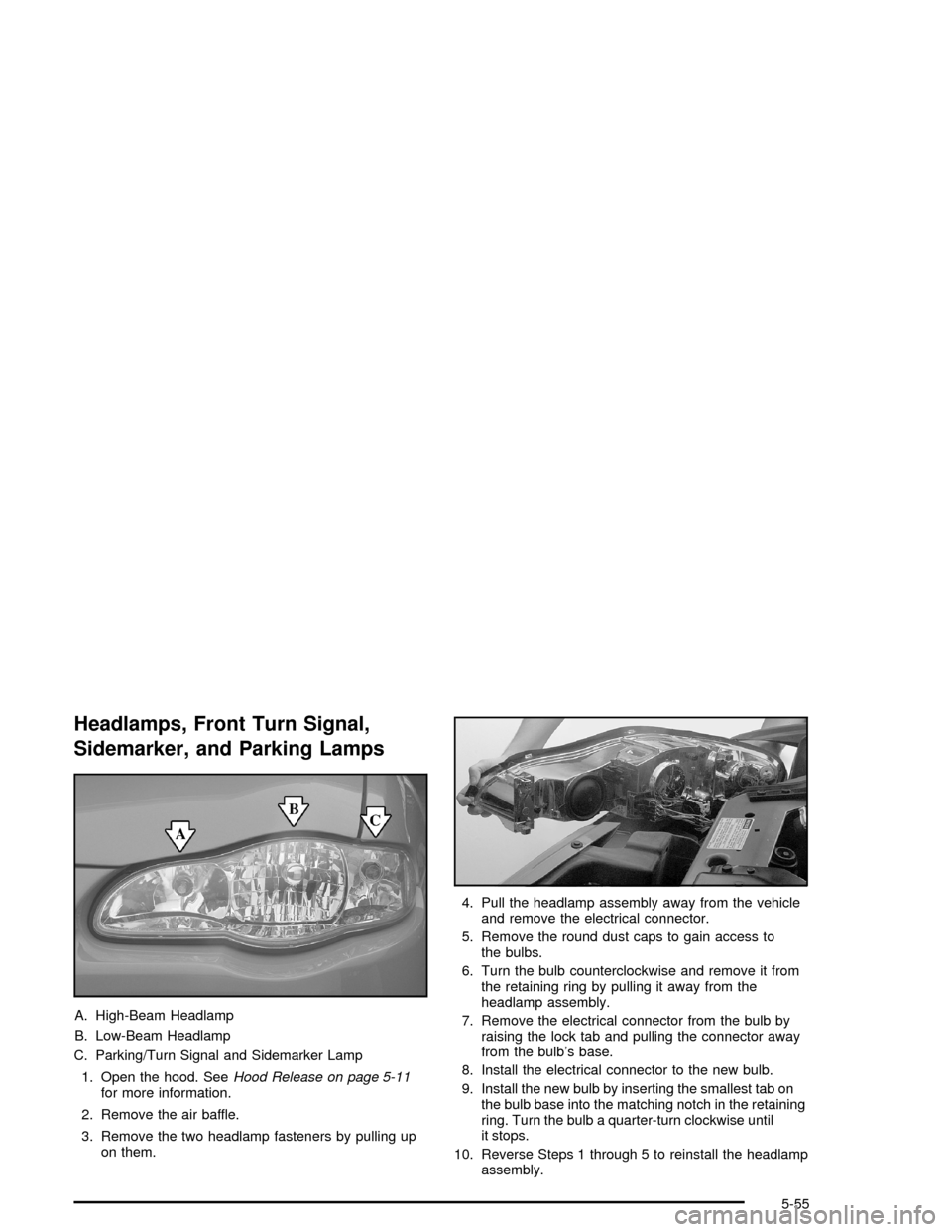hood release CHEVROLET MONTE CARLO 2005 6.G Owners Manual
[x] Cancel search | Manufacturer: CHEVROLET, Model Year: 2005, Model line: MONTE CARLO, Model: CHEVROLET MONTE CARLO 2005 6.GPages: 392, PDF Size: 9.78 MB
Page 113 of 392

The main components of your instrument panel are listed here:
A. Instrument Panel Fuse Block. See “Instrument Panel
Fuse Block” underFuses and Circuit Breakers on
page 5-97.
B. Turn Signal/Multifunction Lever. SeeTurn
Signal/Multifunction Lever on page 3-7.
C. Audio Steering Wheel Controls (If Equipped). See
Audio Steering Wheel Controls on page 3-89.
D. Instrument Panel Cluster. SeeInstrument Panel
Cluster on page 3-28.
E. Hazard Warning Flasher Button. SeeHazard
Warning Flashers on page 3-6.
F. Audio System. SeeAudio System(s) on page 3-54.
G. Air Outlet. See “Outlet Adjustment” underDual
Climate Control System on page 3-22.
H. Exterior Lamps Control. SeeExterior Lamps on
page 3-13.I. Remote Trunk Release. See “Remote Trunk
Release” underTrunk on page 2-10.
J. Tilt Steering Wheel Lever. SeeTilt Wheel on
page 3-6.
K. Hood Release. SeeHood Release on page 5-11.
L. Steering Wheel Cruise Control (If Equipped).
SeeCruise Control on page 3-10.
M. Ignition Switch. See “Ignition Positions” underNew
Vehicle Break-In on page 2-16.
N. Automatic Transaxle Shift Lever. SeeAutomatic
Transaxle Operation on page 2-20.
O. Climate Controls. SeeDual Climate Control System
on page 3-22.
P. Glove Box. SeeGlove Box on page 2-36.
3-5
Page 247 of 392

Service............................................................5-3
Doing Your Own Service Work.........................5-4
Adding Equipment to the Outside of Your
Vehicle......................................................5-5
Fuel................................................................5-5
Gasoline Octane............................................5-5
Gasoline Speci�cations....................................5-5
California Fuel...............................................5-6
Additives.......................................................5-6
Fuels in Foreign Countries...............................5-7
Filling the Tank..............................................5-8
Filling a Portable Fuel Container.....................5-10
Checking Things Under the Hood....................5-10
Hood Release..............................................5-11
Engine Compartment Overview.......................5-12
Engine Oil...................................................5-18
Engine Oil Life System..................................5-21
Supercharger Oil..........................................5-23
Engine Air Cleaner/Filter................................5-24
Automatic Transaxle Fluid..............................5-26
Engine Coolant.............................................5-28
Radiator Pressure Cap..................................5-31
Engine Overheating.......................................5-31
Overheated Engine Protection Operating Mode . . .5-33
Cooling System............................................5-34
Power Steering Fluid.....................................5-43Windshield Washer Fluid................................5-44
Brakes........................................................5-45
Battery........................................................5-48
Jump Starting...............................................5-48
Headlamp Aiming...........................................5-54
Bulb Replacement..........................................5-54
Halogen Bulbs..............................................5-54
Headlamps, Front Turn Signal, Sidemarker,
and Parking Lamps....................................5-55
Taillamps, Turn Signal, Stoplamps and
Sidemarker Lamps.....................................5-56
Back-Up Lamps............................................5-57
Replacement Bulbs.......................................5-57
Windshield Wiper Blade Replacement..............5-58
Tires..............................................................5-59
Tire Sidewall Labelling...................................5-60
Tire Terminology and De�nitions.....................5-62
In�ation - Tire Pressure.................................5-65
Tire Pressure Monitor System.........................5-66
Tire Inspection and Rotation...........................5-68
When It Is Time for New Tires.......................5-69
Buying New Tires.........................................5-70
Uniform Tire Quality Grading..........................5-71
Wheel Alignment and Tire Balance..................5-72
Wheel Replacement......................................5-72
Section 5 Service and Appearance Care
5-1
Page 257 of 392

Hood Release
To open the hood do the following:
1. Pull the handle with
this symbol on it. It is
located inside the
vehicle near the
parking brake pedal.
2. Then go to the front of the vehicle and release the
secondary hood release.
3. Lift the hood.
Before closing the hood, be sure all the �ller caps
are on properly. Then pull the hood down and close
it �rmly.
5-11
Page 301 of 392

Headlamps, Front Turn Signal,
Sidemarker, and Parking Lamps
A. High-Beam Headlamp
B. Low-Beam Headlamp
C. Parking/Turn Signal and Sidemarker Lamp
1. Open the hood. SeeHood Release on page 5-11
for more information.
2. Remove the air baffle.
3. Remove the two headlamp fasteners by pulling up
on them.4. Pull the headlamp assembly away from the vehicle
and remove the electrical connector.
5. Remove the round dust caps to gain access to
the bulbs.
6. Turn the bulb counterclockwise and remove it from
the retaining ring by pulling it away from the
headlamp assembly.
7. Remove the electrical connector from the bulb by
raising the lock tab and pulling the connector away
from the bulb’s base.
8. Install the electrical connector to the new bulb.
9. Install the new bulb by inserting the smallest tab on
the bulb base into the matching notch in the retaining
ring. Turn the bulb a quarter-turn clockwise until
it stops.
10. Reverse Steps 1 through 5 to reinstall the headlamp
assembly.
5-55
Page 302 of 392

Taillamps, Turn Signal, Stoplamps
and Sidemarker Lamps
A. Rear Sidemarker Lamp
B. Taillamp/Stoplamp
C. Turn Signal Lamp1. Open the trunk. SeeHood Release on page 5-11
for more information.
2. Remove the nut and convenience net, if your
vehicle has one, unhook the net from the upper
wing nut.
3. Pull the carpet away from the rear of the vehicle.
4. Unscrew the two remaining hex nuts.
5. Pull the assembly from the body carefully.
6. Remove the socket by turning it counterclockwise
and pull it out.
7. Pull the bulb out. Do not twist it.
8. Push the new bulb into the socket.
9. Push the socket back into the assembly. Tighten
the socket by turning it clockwise.
10. Reinstall the assembly and the two lower hex nuts.
Make sure that the wires are not pinched between
the body of the vehicle and the mounting screws.
11. Reinstall the carpeting.
12. Reinstall the upper (convenience net) wing nut and
reattach convenience net, if equipped.
5-56
Page 358 of 392

(e)Make sure the safety belt reminder light and all belts,
buckles, latch plates, retractors, and anchorages are
working properly. Look for any other loose or damaged
safety belt system parts. If you see anything that might
keep a safety belt system from doing its job, have it
repaired. Have any torn or frayed safety belts replaced.
Also look for any opened or broken airbag coverings, and
have them repaired or replaced. The airbag system does
not need regular maintenance.
(f)Lubricate all key lock cylinders. Lubricate all hinges
and latches, including those for the body doors, hood,
secondary latch, pivots, spring anchor, release pawl, rear
compartment, glove box door, console door, and any
folding seat hardware. More frequent lubrication may be
required when exposed to a corrosive environment.
Applying silicone grease on weatherstrips with a clean
cloth will make them last longer, seal better, and not stick
or squeak.
(g)If you drive regularly under dusty conditions, the
�lter may require replacement more often.
(h)Change automatic transaxle �uid and �lter if the
vehicle is mainly driven under one or more of these
conditions:
�In heavy city traffic where the outside temperature
regularly reaches 90°F (32°C) or higher.
�In hilly or mountainous terrain.�When doing frequent trailer towing.
�Uses such as found in taxi, police, or delivery
service.
(i)Drain, �ush, and re�ll cooling system. This service
can be complex; you should have your dealer perform
this service. See Engine Coolant on page 5-28for
what to use. Inspect hoses. Clean radiator, condenser,
pressure cap, and �ller neck. Pressure test the
cooling system and pressure cap.
(j)Check throttle system for interference or binding and
for damaged or missing parts. Replace parts as
needed. Replace any components that have high effort
or excessive wear. Do not lubricate accelerator or
cruise control cables.
(k)A �uid loss in any vehicle system could indicate a
problem. Have the system inspected and repaired
and the �uid level checked. Add �uid if needed.
(l)For supercharged engines only: Check the
supercharger oil level and add the proper supercharger
oil as needed (or every 36 months, whichever occurs
�rst). See Recommended Fluids and Lubricants on
page 6-12.
(m)If you drive regularly under dusty conditions, inspect
the �lter at each engine oil change.
(n)Visually inspect belt for fraying, excessive cracks, or
obvious damage. Replace belt if necessary.
6-8
Page 362 of 392

Recommended Fluids and
Lubricants
Fluids and lubricants identi�ed below by name, part
number or speci�cation may be obtained from your
dealer.
Usage Fluid/Lubricant
Engine OilEngine oil which meets GM
Standard GM6094M and displays
the American Petroleum Institute
Certi�ed for Gasoline Engines
starburst symbol. GM
Goodwrench
®oil meets all the
requirements for your vehicle. To
determine the proper viscosity for
your vehicle’s engine, seeEngine
Oil on page 5-18.
Engine Coolant50/50 mixture of clean, drinkable
water and use only DEX-COOL
®
Coolant. SeeEngine Coolant on
page 5-28.
Hydraulic Brake
SystemDelco Supreme 11 Brake Fluid or
equivalent DOT-3 brake �uid.
Windshield
Washer SolventGM Optikleen
®Washer Solvent.
Power Steering
SystemGM Power Steering Fluid
(GM Part No. U.S. 89021184,
in Canada 89021186).
Usage Fluid/Lubricant
Automatic
TransaxleDEXRON®-III Automatic
Transmission Fluid. Look for
“Approved for the H-Speci�cation”
on the label.
Key Lock
CylindersMulti-Purpose Lubricant, Superlube
(GM Part No. U.S. 12346241, in
Canada 10953474).
SuperchargerSupercharger Oil (GM Part No.
U.S. 12345982, in Canada
10953513). SeeSupercharger Oil
on page 5-23.
Hood Latch
Assembly,
Secondary
Latch, Pivots,
Spring Anchor
and Release
PawlLubriplate Lubricant Aerosol (GM
Part No. U.S. 12346293, in Canada
992723) or lubricant meeting
requirements of NLGI #2, Category
LB or GC-LB.
Hood and Door
HingesMulti-Purpose Lubricant, Superlube
(GM Part No. U.S. 12346241, in
Canada 10953474).
Weatherstrip
ConditioningDielectric Silicone Grease (GM
Part No. U.S. 12345579, in
Canada 992887).
6-12
Page 384 of 392

Gasoline
Octane........................................................ 5-5
Speci�cations............................................... 5-5
Glove Box.....................................................2-36
GM Mobility Reimbursement Program.................. 7-5
H
Hazard Warning Flashers................................... 3-6
Head Restraints............................................... 1-6
Headlamp
Aiming.......................................................5-54
Headlamp Wiring............................................5-97
Headlamps
Bulb Replacement.......................................5-54
Daytime Running Lamps/Automatic
Headlamp System....................................3-14
Delayed.....................................................3-14
Flash-to-Pass............................................... 3-8
Halogen Bulbs............................................5-54
Headlamps, Front Turn Signal, Sidemarker,
and Parking Lamps..................................5-55
High/Low Beam Changer................................ 3-8
Heated Seats................................................... 1-4
Heater...........................................................3-22Highbeam On Light.........................................3-41
Highbeam Out Warning Message......................3-50
Highway Hypnosis...........................................4-22
Hill and Mountain Roads..................................4-23
HomeLink
®Wireless Control System.................2-32
HomeLink®Wireless Control System Operation . . . 2-33
Hood
Checking Things Under................................5-10
Release.....................................................5-11
Horn............................................................... 3-6
Hot Coolant Temperature Warning Message........3-44
How to Use This Manual...................................... ii
How to Wear Safety Belts Properly...................1-14
I
Ignition Positions.............................................2-16
Infants and Young Children, Restraints...............1-29
In�ation -- Tire Pressure..................................5-65
Instrument Panel
Overview..................................................... 3-4
Instrument Panel (I/P)
Brightness..................................................3-18
Cluster.......................................................3-28
Interior Lamps................................................3-16
6